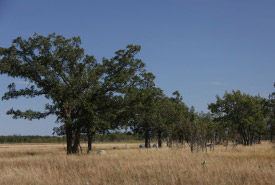Tall Grass Prairie Natural Area

Tall grass prairie, Manitoba (Photo by NCC)
The tall grass prairie ecosystem once stretched from near present-day Winnipeg all the way south to Texas. Today, the largest intact blocks of tall grass prairie in Canada occur in the Tall Grass Prairie Natural Area.
The area supports a diversity of habitat types, including wet and dry tall grass prairie, marshes and fens, savannah and dense woodlands, riparian (riverbank) areas and rivers.
Thousands of species are known to use these habitats, including many that are listed on national or provincial endangered species lists. Over half of Manitoba's population of endangered western prairie white-fringed orchid occurs here.
Prior to European settlement, the native species present in this natural area developed or evolved in the presence of wildfire. Recurrent fire promotes a landscape of open prairie and savannah. In the absence of fire, however, woody species such as aspen and basket willow encroach on the open prairie, causing a shift in habitat to a wood and shrub-dominated system. NCC uses prescribed fire as well as a range of agricultural activities, such as haying and managed grazing, as habitat management tools to control the intrusion of woody invasive species.
For more information about the Tall Grass Prairie and the conservation work NCC is undertaking in the region, see NCC’s Tall Grass Prairie Natural Area Conservation Plan.
Species at Risk
Southeastern Manitoba is very fortunate to live in an area with an abundance of nature and wildlife. Some of the species people live alongside have been identified as requiring special care and management to ensure their Manitoba-based populations continue to exist. These species are known as species at risk (SAR). A booklet was created a means of raising awareness for all 28 SAR in the tall-grass prairie ecosystem, an ecosystem that itself is endangered. This booklet is an easy to read, accessible tool which includes information on well-known species and others that are less familiar.
Find a copy of the booklet here
Infrastructure
The Nature Conservancy of Canada (NCC) was approached by the Government of Manitoba’s Manitoba Infrastructure department on July 21, 2021 with a request to purchase frontage along an 80 ac NCC property along the south side of highway 201, as part of a broader government plan to reconstruct a roadside drain.
On the same day NCC requested that Manitoba Infrastructure clarify some details and requested additional information in order to be able to assess the request. NCC has been informed that government staff are working on a reply but we have not received one to-date.
Once NCC receives the requested information from the Government of Manitoba, NCC will be able to begin the process of assessing the request.
Hydrology
To learn more about NCC and partner's work to better understand hydrology in the tall-grass prairie, click here.
NatureTalks Webinar: Poweshiek skipperling - Recovery tales of a tiny butterfly
When you hear the word endangered, what comes to mind? Probably not a tiny brown and orange butterfly. Even rarer than a panda, the Poweshiek skipperling has only been observed in seven Canadian locations within the last five years, all of which are located in the Nature Conservancy of Canada’s Tall Grass Prairie Natural Area in southeastern Manitoba.
Meet the conservation staff from the Nature Conservancy of Canada, Assiniboine Park Zoo and U.S. Fish and Wildlife Service who lead the international recovery efforts of the Poweshiek skipperling, and discover how their collaboration is helping improve Poweshiek skipperling populations in North America.




